Case Study on Congestive Heart Failure
VerifiedAdded on 2023/01/17
|11
|3229
|27
AI Summary
This case study focuses on a patient with congestive heart failure (CHF) and discusses the priority problems, nursing interventions, and discharge planning. It covers impaired gas exchange and decreased cardiac output as primary health priorities and suggests interventions such as supplemental oxygen, patient positioning, and administration of diuretics. The case study concludes with the importance of patient education and discharge planning to prevent further complications of CHF.
Contribute Materials
Your contribution can guide someone’s learning journey. Share your
documents today.
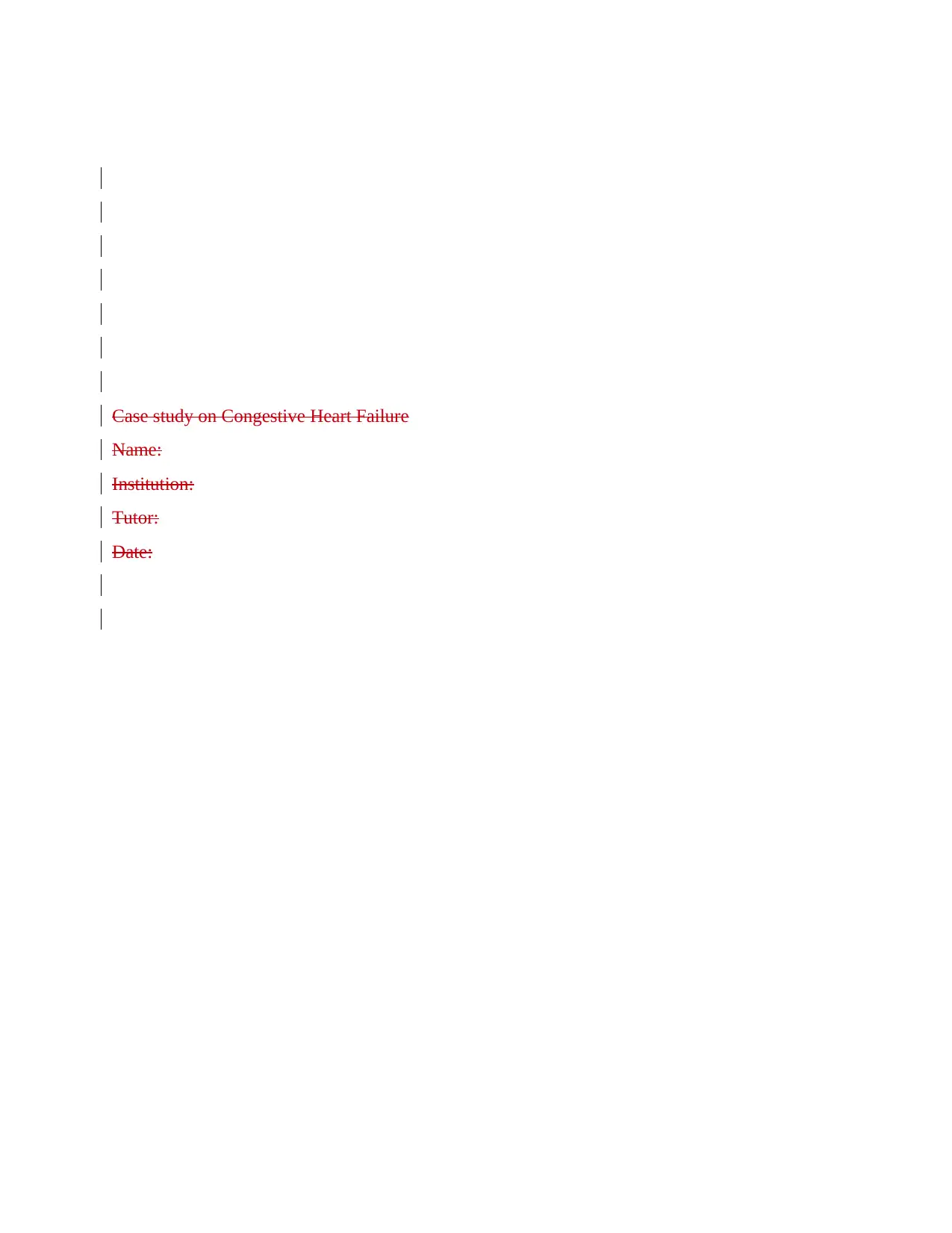
Case study on Congestive Heart Failure
Name:
Institution:
Tutor:
Date:
Name:
Institution:
Tutor:
Date:
Secure Best Marks with AI Grader
Need help grading? Try our AI Grader for instant feedback on your assignments.
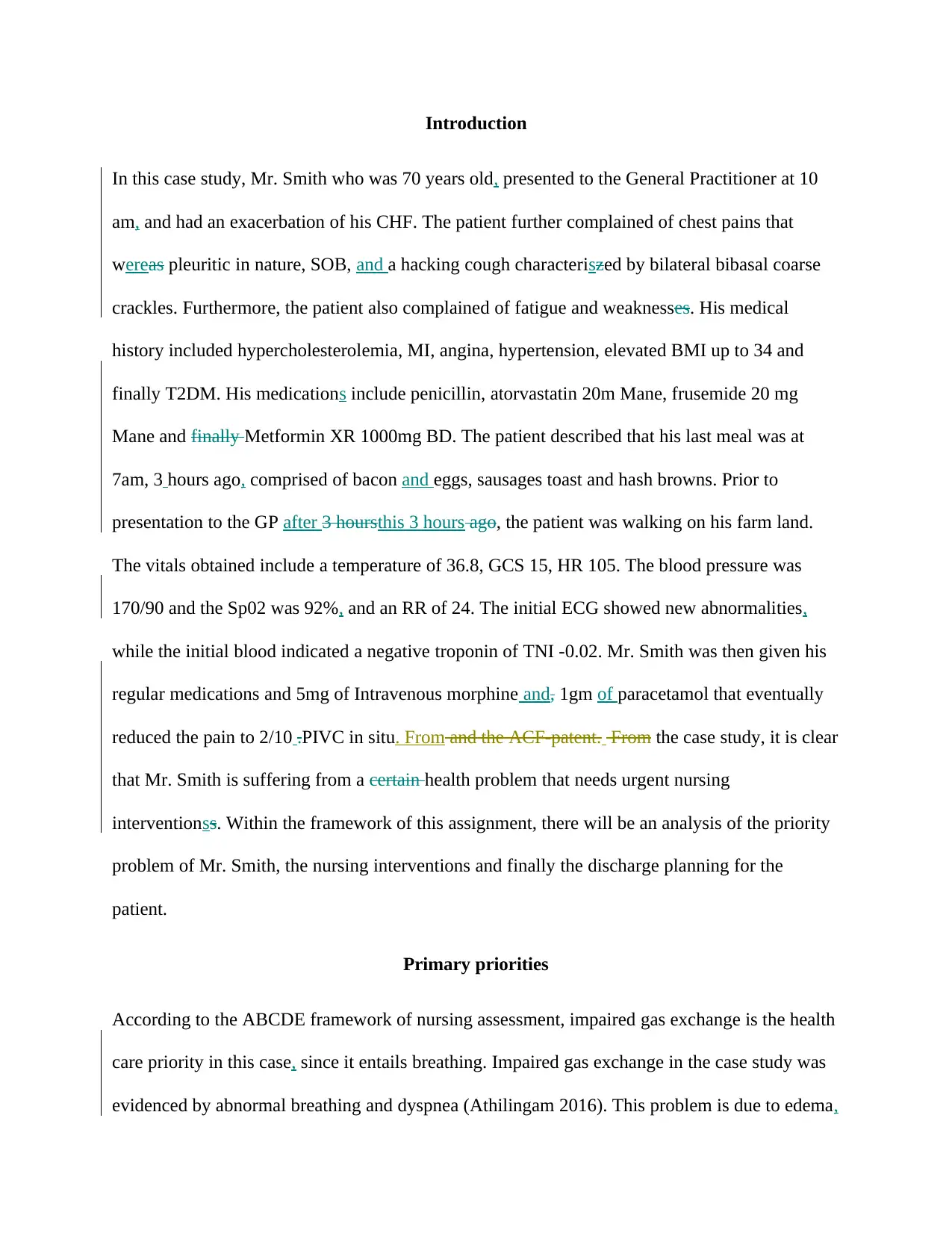
Introduction
In this case study, Mr. Smith who was 70 years old, presented to the General Practitioner at 10
am, and had an exacerbation of his CHF. The patient further complained of chest pains that
wereas pleuritic in nature, SOB, and a hacking cough characteriszed by bilateral bibasal coarse
crackles. Furthermore, the patient also complained of fatigue and weaknesses. His medical
history included hypercholesterolemia, MI, angina, hypertension, elevated BMI up to 34 and
finally T2DM. His medications include penicillin, atorvastatin 20m Mane, frusemide 20 mg
Mane and finally Metformin XR 1000mg BD. The patient described that his last meal was at
7am, 3 hours ago, comprised of bacon and eggs, sausages toast and hash browns. Prior to
presentation to the GP after 3 hoursthis 3 hours ago, the patient was walking on his farm land.
The vitals obtained include a temperature of 36.8, GCS 15, HR 105. The blood pressure was
170/90 and the Sp02 was 92%, and an RR of 24. The initial ECG showed new abnormalities,
while the initial blood indicated a negative troponin of TNI -0.02. Mr. Smith was then given his
regular medications and 5mg of Intravenous morphine and, 1gm of paracetamol that eventually
reduced the pain to 2/10 .PIVC in situ. From and the ACF-patent. From the case study, it is clear
that Mr. Smith is suffering from a certain health problem that needs urgent nursing
interventionss. Within the framework of this assignment, there will be an analysis of the priority
problem of Mr. Smith, the nursing interventions and finally the discharge planning for the
patient.
Primary priorities
According to the ABCDE framework of nursing assessment, impaired gas exchange is the health
care priority in this case, since it entails breathing. Impaired gas exchange in the case study was
evidenced by abnormal breathing and dyspnea (Athilingam 2016). This problem is due to edema,
In this case study, Mr. Smith who was 70 years old, presented to the General Practitioner at 10
am, and had an exacerbation of his CHF. The patient further complained of chest pains that
wereas pleuritic in nature, SOB, and a hacking cough characteriszed by bilateral bibasal coarse
crackles. Furthermore, the patient also complained of fatigue and weaknesses. His medical
history included hypercholesterolemia, MI, angina, hypertension, elevated BMI up to 34 and
finally T2DM. His medications include penicillin, atorvastatin 20m Mane, frusemide 20 mg
Mane and finally Metformin XR 1000mg BD. The patient described that his last meal was at
7am, 3 hours ago, comprised of bacon and eggs, sausages toast and hash browns. Prior to
presentation to the GP after 3 hoursthis 3 hours ago, the patient was walking on his farm land.
The vitals obtained include a temperature of 36.8, GCS 15, HR 105. The blood pressure was
170/90 and the Sp02 was 92%, and an RR of 24. The initial ECG showed new abnormalities,
while the initial blood indicated a negative troponin of TNI -0.02. Mr. Smith was then given his
regular medications and 5mg of Intravenous morphine and, 1gm of paracetamol that eventually
reduced the pain to 2/10 .PIVC in situ. From and the ACF-patent. From the case study, it is clear
that Mr. Smith is suffering from a certain health problem that needs urgent nursing
interventionss. Within the framework of this assignment, there will be an analysis of the priority
problem of Mr. Smith, the nursing interventions and finally the discharge planning for the
patient.
Primary priorities
According to the ABCDE framework of nursing assessment, impaired gas exchange is the health
care priority in this case, since it entails breathing. Impaired gas exchange in the case study was
evidenced by abnormal breathing and dyspnea (Athilingam 2016). This problem is due to edema,
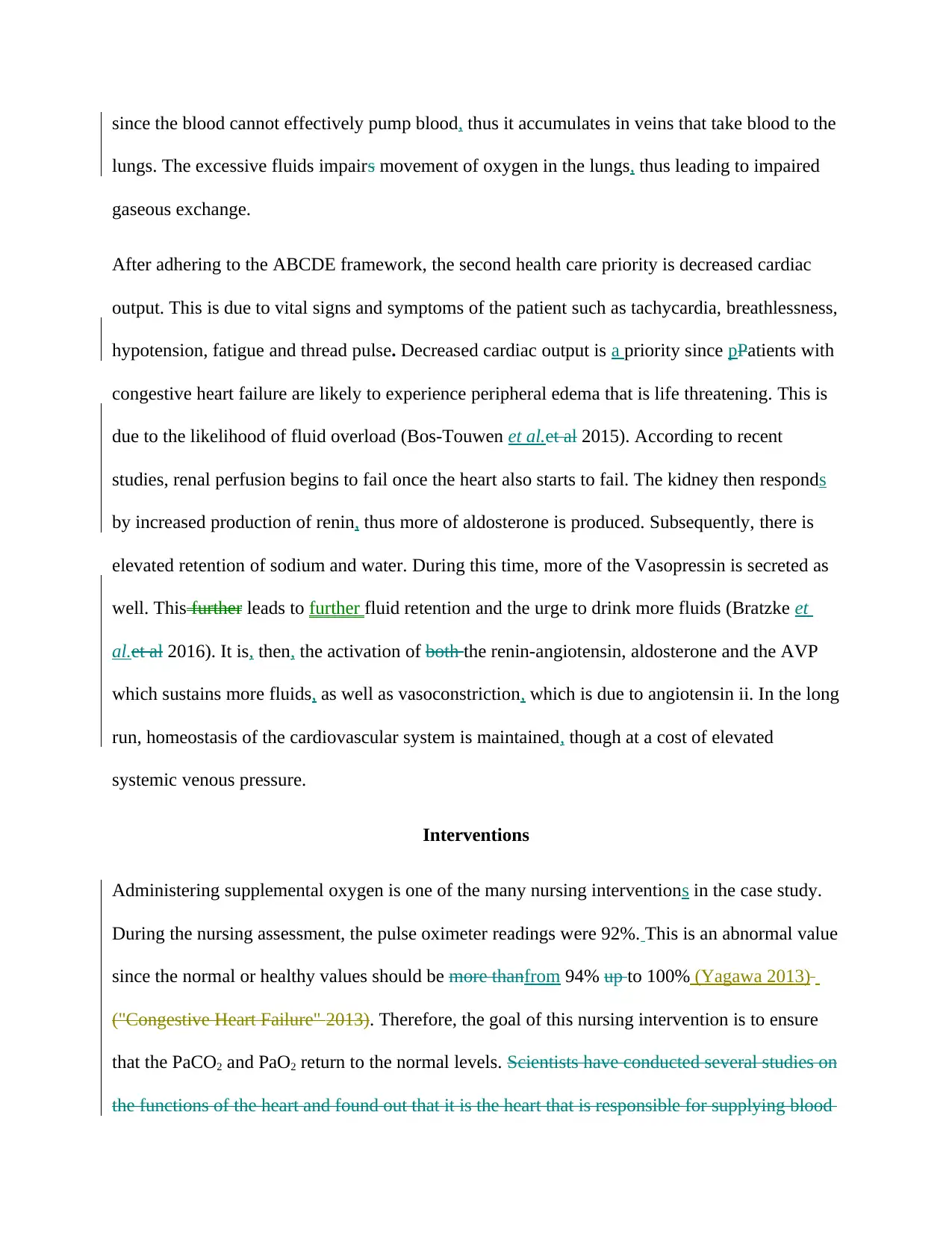
since the blood cannot effectively pump blood, thus it accumulates in veins that take blood to the
lungs. The excessive fluids impairs movement of oxygen in the lungs, thus leading to impaired
gaseous exchange.
After adhering to the ABCDE framework, the second health care priority is decreased cardiac
output. This is due to vital signs and symptoms of the patient such as tachycardia, breathlessness,
hypotension, fatigue and thread pulse. Decreased cardiac output is a priority since pPatients with
congestive heart failure are likely to experience peripheral edema that is life threatening. This is
due to the likelihood of fluid overload (Bos-Touwen et al.et al 2015). According to recent
studies, renal perfusion begins to fail once the heart also starts to fail. The kidney then responds
by increased production of renin, thus more of aldosterone is produced. Subsequently, there is
elevated retention of sodium and water. During this time, more of the Vasopressin is secreted as
well. This further leads to further fluid retention and the urge to drink more fluids (Bratzke et
al.et al 2016). It is, then, the activation of both the renin-angiotensin, aldosterone and the AVP
which sustains more fluids, as well as vasoconstriction, which is due to angiotensin ii. In the long
run, homeostasis of the cardiovascular system is maintained, though at a cost of elevated
systemic venous pressure.
Interventions
Administering supplemental oxygen is one of the many nursing interventions in the case study.
During the nursing assessment, the pulse oximeter readings were 92%. This is an abnormal value
since the normal or healthy values should be more thanfrom 94% up to 100% (Yagawa 2013)
("Congestive Heart Failure" 2013). Therefore, the goal of this nursing intervention is to ensure
that the PaCO2 and PaO2 return to the normal levels. Scientists have conducted several studies on
the functions of the heart and found out that it is the heart that is responsible for supplying blood
lungs. The excessive fluids impairs movement of oxygen in the lungs, thus leading to impaired
gaseous exchange.
After adhering to the ABCDE framework, the second health care priority is decreased cardiac
output. This is due to vital signs and symptoms of the patient such as tachycardia, breathlessness,
hypotension, fatigue and thread pulse. Decreased cardiac output is a priority since pPatients with
congestive heart failure are likely to experience peripheral edema that is life threatening. This is
due to the likelihood of fluid overload (Bos-Touwen et al.et al 2015). According to recent
studies, renal perfusion begins to fail once the heart also starts to fail. The kidney then responds
by increased production of renin, thus more of aldosterone is produced. Subsequently, there is
elevated retention of sodium and water. During this time, more of the Vasopressin is secreted as
well. This further leads to further fluid retention and the urge to drink more fluids (Bratzke et
al.et al 2016). It is, then, the activation of both the renin-angiotensin, aldosterone and the AVP
which sustains more fluids, as well as vasoconstriction, which is due to angiotensin ii. In the long
run, homeostasis of the cardiovascular system is maintained, though at a cost of elevated
systemic venous pressure.
Interventions
Administering supplemental oxygen is one of the many nursing interventions in the case study.
During the nursing assessment, the pulse oximeter readings were 92%. This is an abnormal value
since the normal or healthy values should be more thanfrom 94% up to 100% (Yagawa 2013)
("Congestive Heart Failure" 2013). Therefore, the goal of this nursing intervention is to ensure
that the PaCO2 and PaO2 return to the normal levels. Scientists have conducted several studies on
the functions of the heart and found out that it is the heart that is responsible for supplying blood
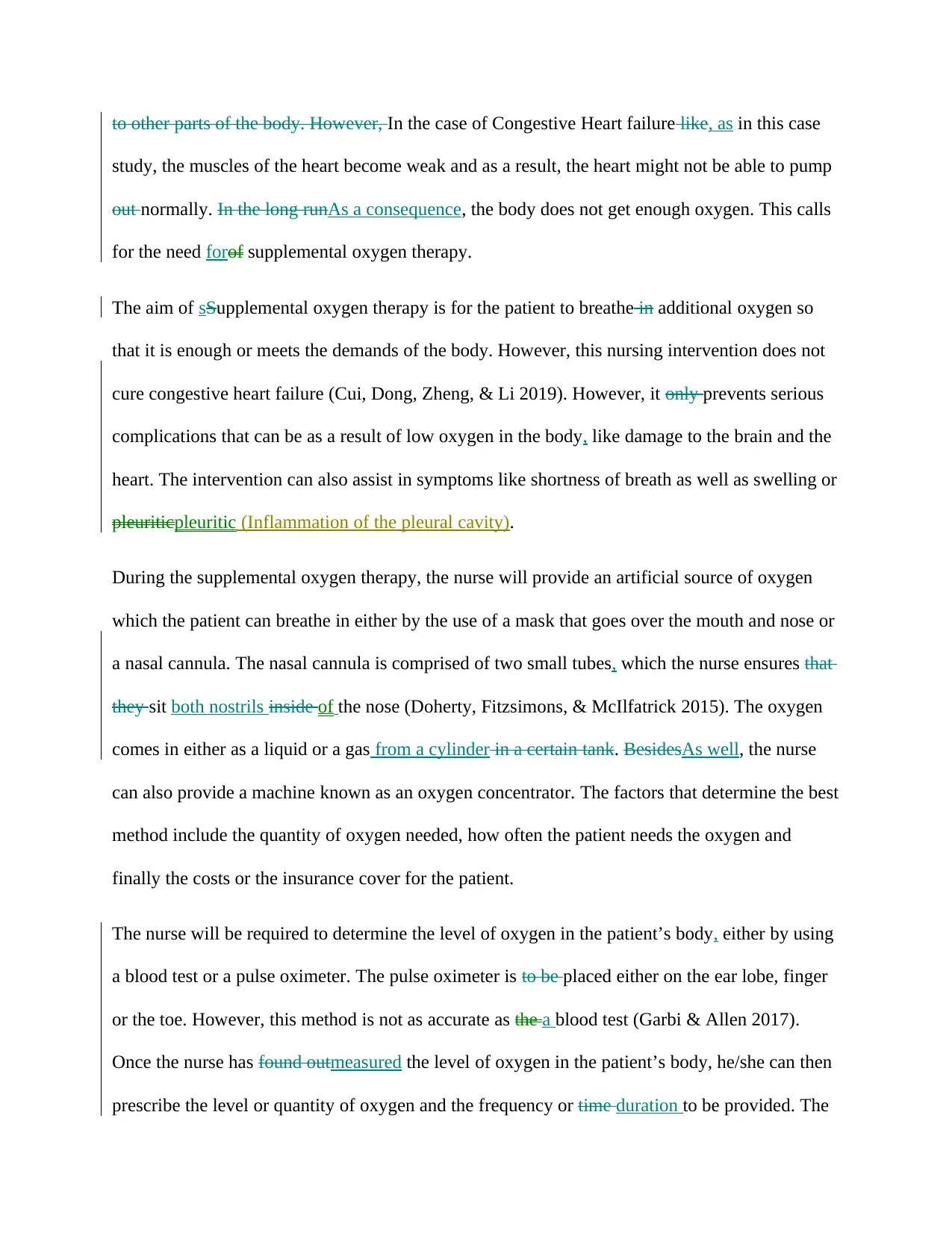
to other parts of the body. However, In the case of Congestive Heart failure like, as in this case
study, the muscles of the heart become weak and as a result, the heart might not be able to pump
out normally. In the long runAs a consequence, the body does not get enough oxygen. This calls
for the need forof supplemental oxygen therapy.
The aim of sSupplemental oxygen therapy is for the patient to breathe in additional oxygen so
that it is enough or meets the demands of the body. However, this nursing intervention does not
cure congestive heart failure (Cui, Dong, Zheng, & Li 2019). However, it only prevents serious
complications that can be as a result of low oxygen in the body, like damage to the brain and the
heart. The intervention can also assist in symptoms like shortness of breath as well as swelling or
pleuriticpleuritic (Inflammation of the pleural cavity).
During the supplemental oxygen therapy, the nurse will provide an artificial source of oxygen
which the patient can breathe in either by the use of a mask that goes over the mouth and nose or
a nasal cannula. The nasal cannula is comprised of two small tubes, which the nurse ensures that
they sit both nostrils inside of the nose (Doherty, Fitzsimons, & McIlfatrick 2015). The oxygen
comes in either as a liquid or a gas from a cylinder in a certain tank. BesidesAs well, the nurse
can also provide a machine known as an oxygen concentrator. The factors that determine the best
method include the quantity of oxygen needed, how often the patient needs the oxygen and
finally the costs or the insurance cover for the patient.
The nurse will be required to determine the level of oxygen in the patient’s body, either by using
a blood test or a pulse oximeter. The pulse oximeter is to be placed either on the ear lobe, finger
or the toe. However, this method is not as accurate as the a blood test (Garbi & Allen 2017).
Once the nurse has found outmeasured the level of oxygen in the patient’s body, he/she can then
prescribe the level or quantity of oxygen and the frequency or time duration to be provided. The
study, the muscles of the heart become weak and as a result, the heart might not be able to pump
out normally. In the long runAs a consequence, the body does not get enough oxygen. This calls
for the need forof supplemental oxygen therapy.
The aim of sSupplemental oxygen therapy is for the patient to breathe in additional oxygen so
that it is enough or meets the demands of the body. However, this nursing intervention does not
cure congestive heart failure (Cui, Dong, Zheng, & Li 2019). However, it only prevents serious
complications that can be as a result of low oxygen in the body, like damage to the brain and the
heart. The intervention can also assist in symptoms like shortness of breath as well as swelling or
pleuriticpleuritic (Inflammation of the pleural cavity).
During the supplemental oxygen therapy, the nurse will provide an artificial source of oxygen
which the patient can breathe in either by the use of a mask that goes over the mouth and nose or
a nasal cannula. The nasal cannula is comprised of two small tubes, which the nurse ensures that
they sit both nostrils inside of the nose (Doherty, Fitzsimons, & McIlfatrick 2015). The oxygen
comes in either as a liquid or a gas from a cylinder in a certain tank. BesidesAs well, the nurse
can also provide a machine known as an oxygen concentrator. The factors that determine the best
method include the quantity of oxygen needed, how often the patient needs the oxygen and
finally the costs or the insurance cover for the patient.
The nurse will be required to determine the level of oxygen in the patient’s body, either by using
a blood test or a pulse oximeter. The pulse oximeter is to be placed either on the ear lobe, finger
or the toe. However, this method is not as accurate as the a blood test (Garbi & Allen 2017).
Once the nurse has found outmeasured the level of oxygen in the patient’s body, he/she can then
prescribe the level or quantity of oxygen and the frequency or time duration to be provided. The
Secure Best Marks with AI Grader
Need help grading? Try our AI Grader for instant feedback on your assignments.
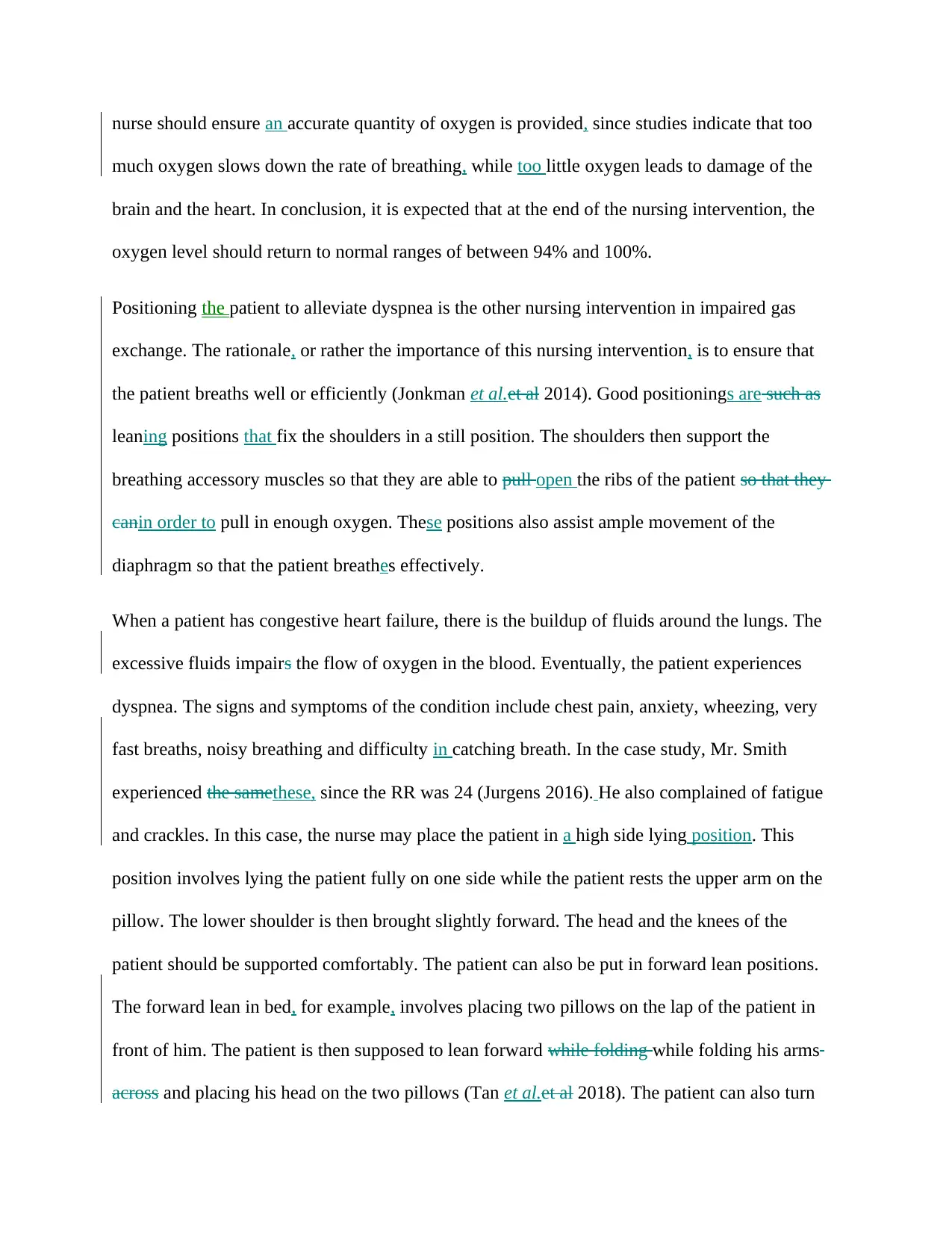
nurse should ensure an accurate quantity of oxygen is provided, since studies indicate that too
much oxygen slows down the rate of breathing, while too little oxygen leads to damage of the
brain and the heart. In conclusion, it is expected that at the end of the nursing intervention, the
oxygen level should return to normal ranges of between 94% and 100%.
Positioning the patient to alleviate dyspnea is the other nursing intervention in impaired gas
exchange. The rationale, or rather the importance of this nursing intervention, is to ensure that
the patient breaths well or efficiently (Jonkman et al.et al 2014). Good positionings are such as
leaning positions that fix the shoulders in a still position. The shoulders then support the
breathing accessory muscles so that they are able to pull open the ribs of the patient so that they
canin order to pull in enough oxygen. These positions also assist ample movement of the
diaphragm so that the patient breathes effectively.
When a patient has congestive heart failure, there is the buildup of fluids around the lungs. The
excessive fluids impairs the flow of oxygen in the blood. Eventually, the patient experiences
dyspnea. The signs and symptoms of the condition include chest pain, anxiety, wheezing, very
fast breaths, noisy breathing and difficulty in catching breath. In the case study, Mr. Smith
experienced the samethese, since the RR was 24 (Jurgens 2016). He also complained of fatigue
and crackles. In this case, the nurse may place the patient in a high side lying position. This
position involves lying the patient fully on one side while the patient rests the upper arm on the
pillow. The lower shoulder is then brought slightly forward. The head and the knees of the
patient should be supported comfortably. The patient can also be put in forward lean positions.
The forward lean in bed, for example, involves placing two pillows on the lap of the patient in
front of him. The patient is then supposed to lean forward while folding while folding his arms
across and placing his head on the two pillows (Tan et al.et al 2018). The patient can also turn
much oxygen slows down the rate of breathing, while too little oxygen leads to damage of the
brain and the heart. In conclusion, it is expected that at the end of the nursing intervention, the
oxygen level should return to normal ranges of between 94% and 100%.
Positioning the patient to alleviate dyspnea is the other nursing intervention in impaired gas
exchange. The rationale, or rather the importance of this nursing intervention, is to ensure that
the patient breaths well or efficiently (Jonkman et al.et al 2014). Good positionings are such as
leaning positions that fix the shoulders in a still position. The shoulders then support the
breathing accessory muscles so that they are able to pull open the ribs of the patient so that they
canin order to pull in enough oxygen. These positions also assist ample movement of the
diaphragm so that the patient breathes effectively.
When a patient has congestive heart failure, there is the buildup of fluids around the lungs. The
excessive fluids impairs the flow of oxygen in the blood. Eventually, the patient experiences
dyspnea. The signs and symptoms of the condition include chest pain, anxiety, wheezing, very
fast breaths, noisy breathing and difficulty in catching breath. In the case study, Mr. Smith
experienced the samethese, since the RR was 24 (Jurgens 2016). He also complained of fatigue
and crackles. In this case, the nurse may place the patient in a high side lying position. This
position involves lying the patient fully on one side while the patient rests the upper arm on the
pillow. The lower shoulder is then brought slightly forward. The head and the knees of the
patient should be supported comfortably. The patient can also be put in forward lean positions.
The forward lean in bed, for example, involves placing two pillows on the lap of the patient in
front of him. The patient is then supposed to lean forward while folding while folding his arms
across and placing his head on the two pillows (Tan et al.et al 2018). The patient can also turn
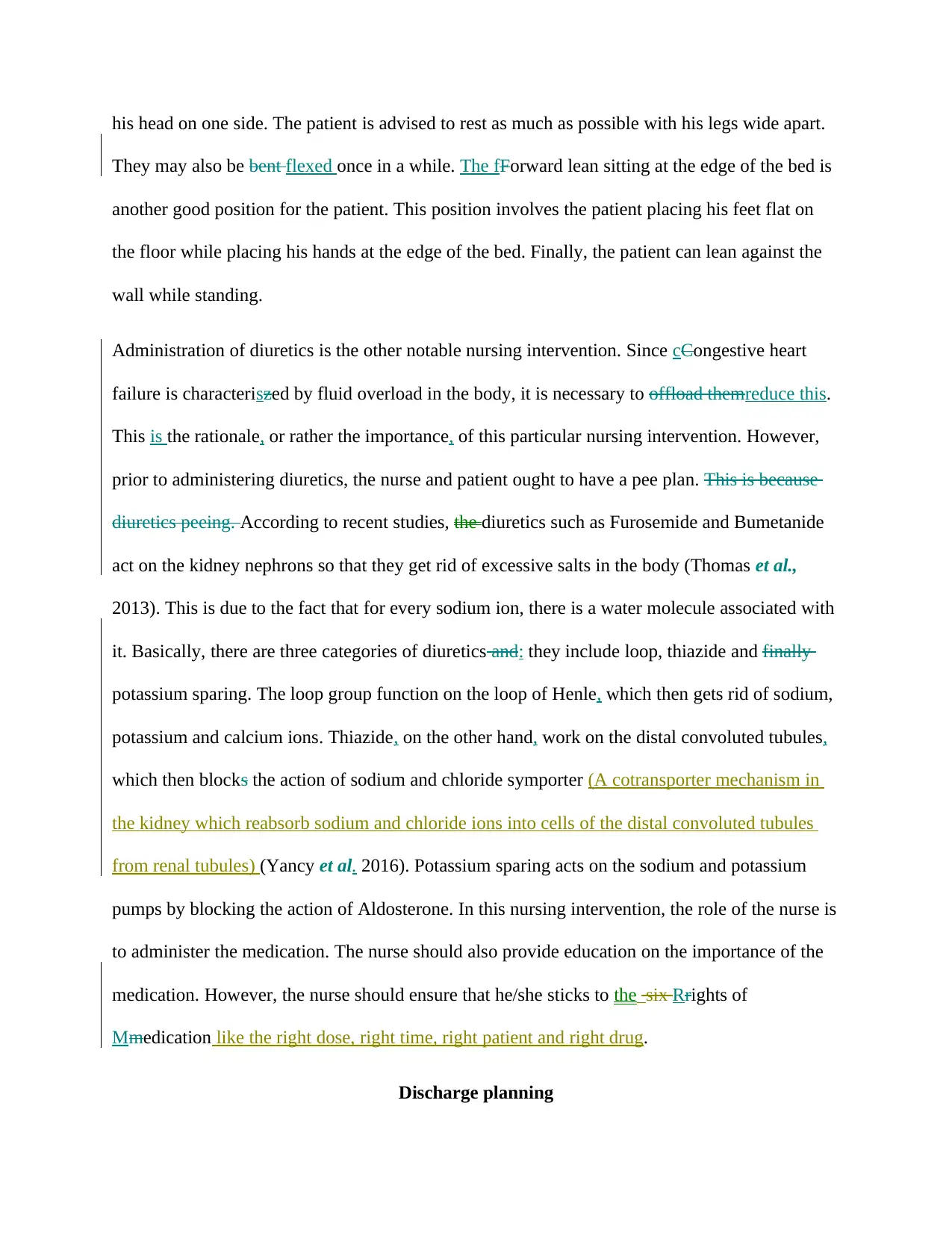
his head on one side. The patient is advised to rest as much as possible with his legs wide apart.
They may also be bent flexed once in a while. The fForward lean sitting at the edge of the bed is
another good position for the patient. This position involves the patient placing his feet flat on
the floor while placing his hands at the edge of the bed. Finally, the patient can lean against the
wall while standing.
Administration of diuretics is the other notable nursing intervention. Since cCongestive heart
failure is characteriszed by fluid overload in the body, it is necessary to offload themreduce this.
This is the rationale, or rather the importance, of this particular nursing intervention. However,
prior to administering diuretics, the nurse and patient ought to have a pee plan. This is because
diuretics peeing. According to recent studies, the diuretics such as Furosemide and Bumetanide
act on the kidney nephrons so that they get rid of excessive salts in the body (Thomas et al.,
2013). This is due to the fact that for every sodium ion, there is a water molecule associated with
it. Basically, there are three categories of diuretics and: they include loop, thiazide and finally
potassium sparing. The loop group function on the loop of Henle, which then gets rid of sodium,
potassium and calcium ions. Thiazide, on the other hand, work on the distal convoluted tubules,
which then blocks the action of sodium and chloride symporter (A cotransporter mechanism in
the kidney which reabsorb sodium and chloride ions into cells of the distal convoluted tubules
from renal tubules) (Yancy et al. 2016). Potassium sparing acts on the sodium and potassium
pumps by blocking the action of Aldosterone. In this nursing intervention, the role of the nurse is
to administer the medication. The nurse should also provide education on the importance of the
medication. However, the nurse should ensure that he/she sticks to the six Rrights of
Mmedication like the right dose, right time, right patient and right drug.
Discharge planning
They may also be bent flexed once in a while. The fForward lean sitting at the edge of the bed is
another good position for the patient. This position involves the patient placing his feet flat on
the floor while placing his hands at the edge of the bed. Finally, the patient can lean against the
wall while standing.
Administration of diuretics is the other notable nursing intervention. Since cCongestive heart
failure is characteriszed by fluid overload in the body, it is necessary to offload themreduce this.
This is the rationale, or rather the importance, of this particular nursing intervention. However,
prior to administering diuretics, the nurse and patient ought to have a pee plan. This is because
diuretics peeing. According to recent studies, the diuretics such as Furosemide and Bumetanide
act on the kidney nephrons so that they get rid of excessive salts in the body (Thomas et al.,
2013). This is due to the fact that for every sodium ion, there is a water molecule associated with
it. Basically, there are three categories of diuretics and: they include loop, thiazide and finally
potassium sparing. The loop group function on the loop of Henle, which then gets rid of sodium,
potassium and calcium ions. Thiazide, on the other hand, work on the distal convoluted tubules,
which then blocks the action of sodium and chloride symporter (A cotransporter mechanism in
the kidney which reabsorb sodium and chloride ions into cells of the distal convoluted tubules
from renal tubules) (Yancy et al. 2016). Potassium sparing acts on the sodium and potassium
pumps by blocking the action of Aldosterone. In this nursing intervention, the role of the nurse is
to administer the medication. The nurse should also provide education on the importance of the
medication. However, the nurse should ensure that he/she sticks to the six Rrights of
Mmedication like the right dose, right time, right patient and right drug.
Discharge planning
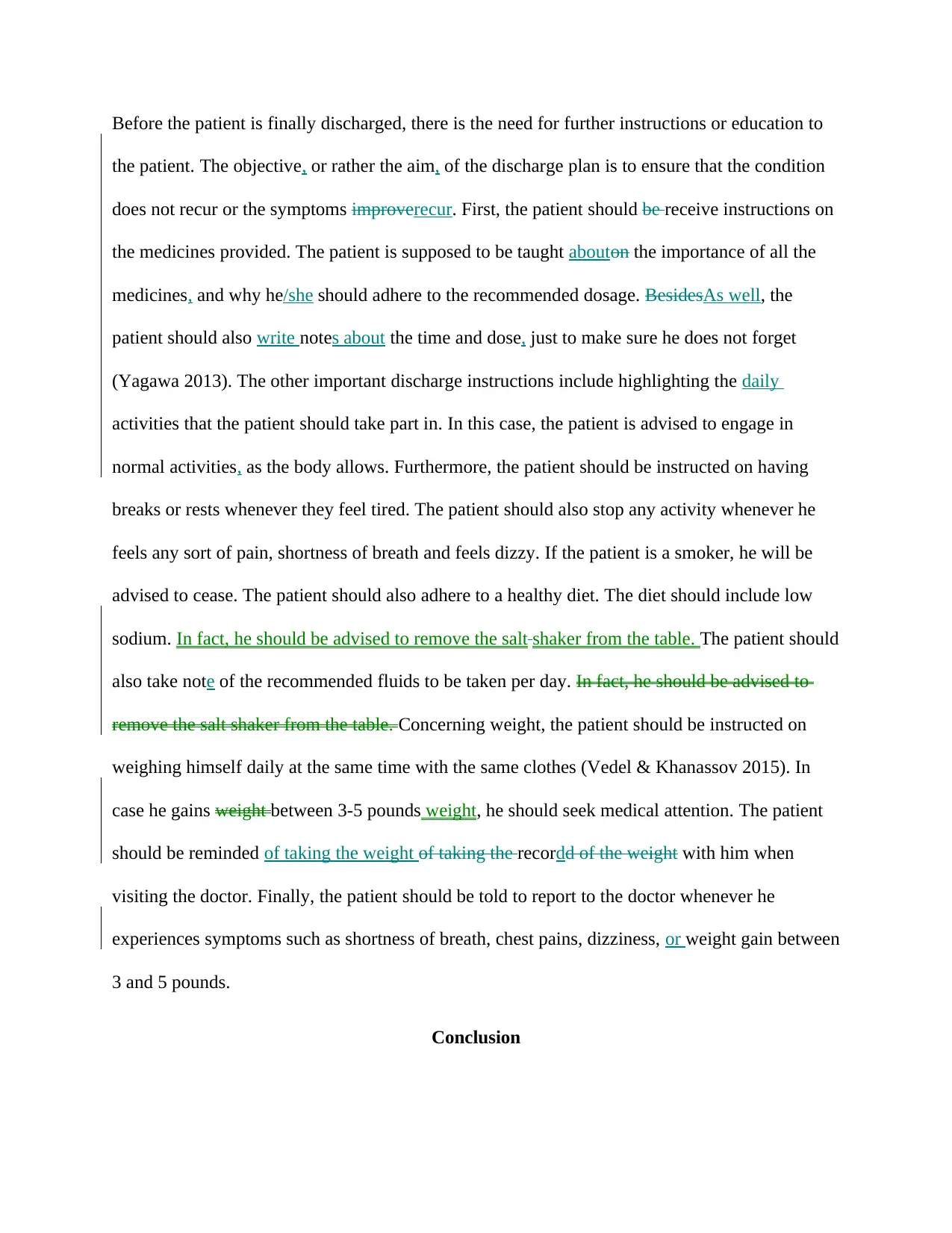
Before the patient is finally discharged, there is the need for further instructions or education to
the patient. The objective, or rather the aim, of the discharge plan is to ensure that the condition
does not recur or the symptoms improverecur. First, the patient should be receive instructions on
the medicines provided. The patient is supposed to be taught abouton the importance of all the
medicines, and why he/she should adhere to the recommended dosage. BesidesAs well, the
patient should also write notes about the time and dose, just to make sure he does not forget
(Yagawa 2013). The other important discharge instructions include highlighting the daily
activities that the patient should take part in. In this case, the patient is advised to engage in
normal activities, as the body allows. Furthermore, the patient should be instructed on having
breaks or rests whenever they feel tired. The patient should also stop any activity whenever he
feels any sort of pain, shortness of breath and feels dizzy. If the patient is a smoker, he will be
advised to cease. The patient should also adhere to a healthy diet. The diet should include low
sodium. In fact, he should be advised to remove the salt shaker from the table. The patient should
also take note of the recommended fluids to be taken per day. In fact, he should be advised to
remove the salt shaker from the table. Concerning weight, the patient should be instructed on
weighing himself daily at the same time with the same clothes (Vedel & Khanassov 2015). In
case he gains weight between 3-5 pounds weight, he should seek medical attention. The patient
should be reminded of taking the weight of taking the recordd of the weight with him when
visiting the doctor. Finally, the patient should be told to report to the doctor whenever he
experiences symptoms such as shortness of breath, chest pains, dizziness, or weight gain between
3 and 5 pounds.
Conclusion
the patient. The objective, or rather the aim, of the discharge plan is to ensure that the condition
does not recur or the symptoms improverecur. First, the patient should be receive instructions on
the medicines provided. The patient is supposed to be taught abouton the importance of all the
medicines, and why he/she should adhere to the recommended dosage. BesidesAs well, the
patient should also write notes about the time and dose, just to make sure he does not forget
(Yagawa 2013). The other important discharge instructions include highlighting the daily
activities that the patient should take part in. In this case, the patient is advised to engage in
normal activities, as the body allows. Furthermore, the patient should be instructed on having
breaks or rests whenever they feel tired. The patient should also stop any activity whenever he
feels any sort of pain, shortness of breath and feels dizzy. If the patient is a smoker, he will be
advised to cease. The patient should also adhere to a healthy diet. The diet should include low
sodium. In fact, he should be advised to remove the salt shaker from the table. The patient should
also take note of the recommended fluids to be taken per day. In fact, he should be advised to
remove the salt shaker from the table. Concerning weight, the patient should be instructed on
weighing himself daily at the same time with the same clothes (Vedel & Khanassov 2015). In
case he gains weight between 3-5 pounds weight, he should seek medical attention. The patient
should be reminded of taking the weight of taking the recordd of the weight with him when
visiting the doctor. Finally, the patient should be told to report to the doctor whenever he
experiences symptoms such as shortness of breath, chest pains, dizziness, or weight gain between
3 and 5 pounds.
Conclusion
Paraphrase This Document
Need a fresh take? Get an instant paraphrase of this document with our AI Paraphraser

In conclusion, congestive heart failure is a condition where the heart does no longer effectively
pumps blood to other parts of the body. This eventually leads to signs and symptoms such as
chest pains, weakness and fatigue. Congestive heart failure is a serious problem that if left
untreated, it can lead to serious complications. The primary health priorities for the condition
include impaired gaseous exchange and decreased cardiac output. The major nursing
interventions for the same include supplemental oxygen and patient positioning. However,
before a patient is discharged, patient education is also necessary. There is the a need for nurses
to understand underlying conditions and utilisze evidence based practice to prevent further
complications of cCongestive heart failure.
References
Athilingam, P. 2016. A Mobile Application to Improve Self-Care of Patients with Heart Failure
Application (HeartMapp) to Improve Self-Management of Patients with Heart Failure. Journal
of Cardiac Failure, 22(8), S102-S103. doi:10.1016/j.cardfail.2016.06.327
pumps blood to other parts of the body. This eventually leads to signs and symptoms such as
chest pains, weakness and fatigue. Congestive heart failure is a serious problem that if left
untreated, it can lead to serious complications. The primary health priorities for the condition
include impaired gaseous exchange and decreased cardiac output. The major nursing
interventions for the same include supplemental oxygen and patient positioning. However,
before a patient is discharged, patient education is also necessary. There is the a need for nurses
to understand underlying conditions and utilisze evidence based practice to prevent further
complications of cCongestive heart failure.
References
Athilingam, P. 2016. A Mobile Application to Improve Self-Care of Patients with Heart Failure
Application (HeartMapp) to Improve Self-Management of Patients with Heart Failure. Journal
of Cardiac Failure, 22(8), S102-S103. doi:10.1016/j.cardfail.2016.06.327
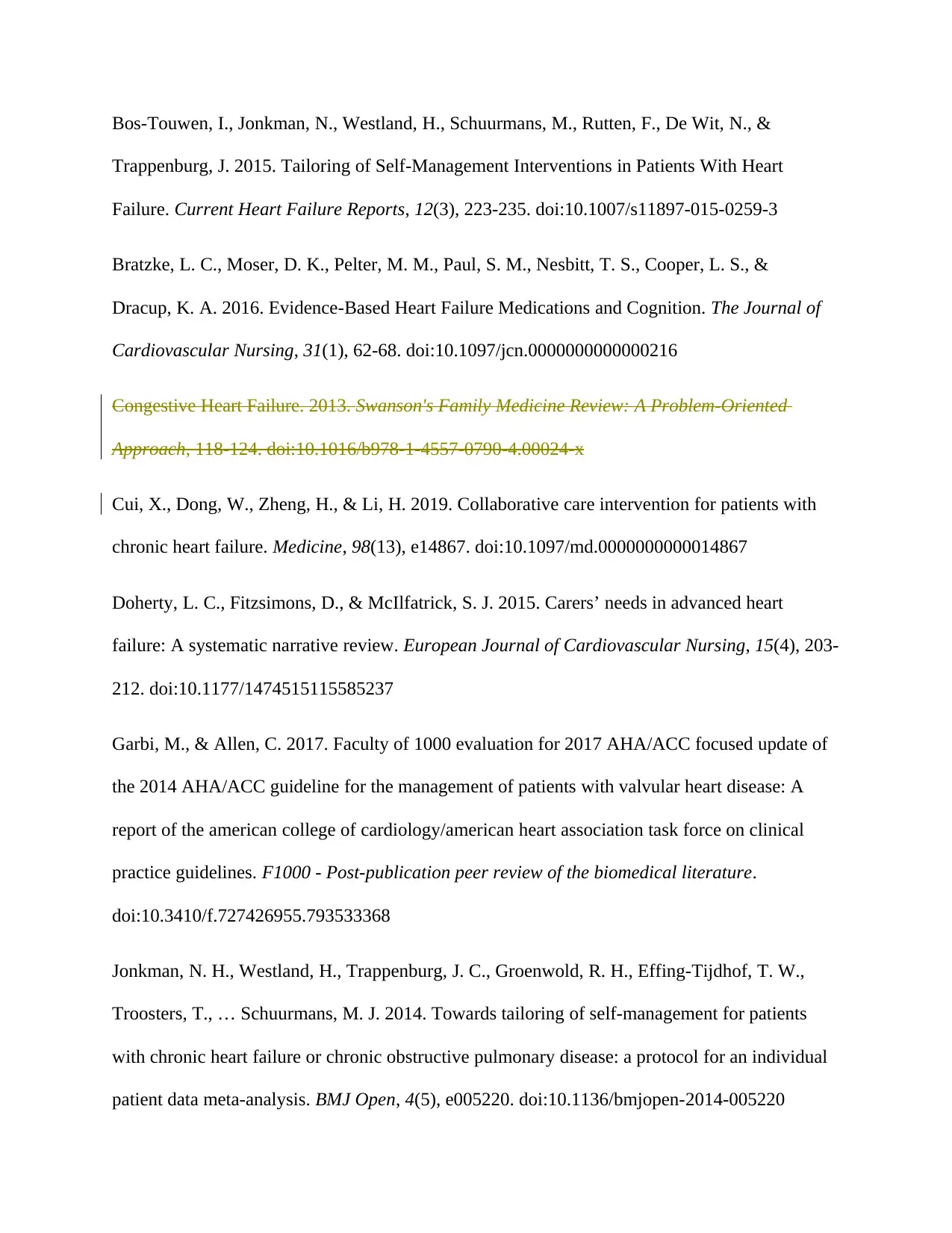
Bos-Touwen, I., Jonkman, N., Westland, H., Schuurmans, M., Rutten, F., De Wit, N., &
Trappenburg, J. 2015. Tailoring of Self-Management Interventions in Patients With Heart
Failure. Current Heart Failure Reports, 12(3), 223-235. doi:10.1007/s11897-015-0259-3
Bratzke, L. C., Moser, D. K., Pelter, M. M., Paul, S. M., Nesbitt, T. S., Cooper, L. S., &
Dracup, K. A. 2016. Evidence-Based Heart Failure Medications and Cognition. The Journal of
Cardiovascular Nursing, 31(1), 62-68. doi:10.1097/jcn.0000000000000216
Congestive Heart Failure. 2013. Swanson's Family Medicine Review: A Problem-Oriented
Approach, 118-124. doi:10.1016/b978-1-4557-0790-4.00024-x
Cui, X., Dong, W., Zheng, H., & Li, H. 2019. Collaborative care intervention for patients with
chronic heart failure. Medicine, 98(13), e14867. doi:10.1097/md.0000000000014867
Doherty, L. C., Fitzsimons, D., & McIlfatrick, S. J. 2015. Carers’ needs in advanced heart
failure: A systematic narrative review. European Journal of Cardiovascular Nursing, 15(4), 203-
212. doi:10.1177/1474515115585237
Garbi, M., & Allen, C. 2017. Faculty of 1000 evaluation for 2017 AHA/ACC focused update of
the 2014 AHA/ACC guideline for the management of patients with valvular heart disease: A
report of the american college of cardiology/american heart association task force on clinical
practice guidelines. F1000 - Post-publication peer review of the biomedical literature.
doi:10.3410/f.727426955.793533368
Jonkman, N. H., Westland, H., Trappenburg, J. C., Groenwold, R. H., Effing-Tijdhof, T. W.,
Troosters, T., … Schuurmans, M. J. 2014. Towards tailoring of self-management for patients
with chronic heart failure or chronic obstructive pulmonary disease: a protocol for an individual
patient data meta-analysis. BMJ Open, 4(5), e005220. doi:10.1136/bmjopen-2014-005220
Trappenburg, J. 2015. Tailoring of Self-Management Interventions in Patients With Heart
Failure. Current Heart Failure Reports, 12(3), 223-235. doi:10.1007/s11897-015-0259-3
Bratzke, L. C., Moser, D. K., Pelter, M. M., Paul, S. M., Nesbitt, T. S., Cooper, L. S., &
Dracup, K. A. 2016. Evidence-Based Heart Failure Medications and Cognition. The Journal of
Cardiovascular Nursing, 31(1), 62-68. doi:10.1097/jcn.0000000000000216
Congestive Heart Failure. 2013. Swanson's Family Medicine Review: A Problem-Oriented
Approach, 118-124. doi:10.1016/b978-1-4557-0790-4.00024-x
Cui, X., Dong, W., Zheng, H., & Li, H. 2019. Collaborative care intervention for patients with
chronic heart failure. Medicine, 98(13), e14867. doi:10.1097/md.0000000000014867
Doherty, L. C., Fitzsimons, D., & McIlfatrick, S. J. 2015. Carers’ needs in advanced heart
failure: A systematic narrative review. European Journal of Cardiovascular Nursing, 15(4), 203-
212. doi:10.1177/1474515115585237
Garbi, M., & Allen, C. 2017. Faculty of 1000 evaluation for 2017 AHA/ACC focused update of
the 2014 AHA/ACC guideline for the management of patients with valvular heart disease: A
report of the american college of cardiology/american heart association task force on clinical
practice guidelines. F1000 - Post-publication peer review of the biomedical literature.
doi:10.3410/f.727426955.793533368
Jonkman, N. H., Westland, H., Trappenburg, J. C., Groenwold, R. H., Effing-Tijdhof, T. W.,
Troosters, T., … Schuurmans, M. J. 2014. Towards tailoring of self-management for patients
with chronic heart failure or chronic obstructive pulmonary disease: a protocol for an individual
patient data meta-analysis. BMJ Open, 4(5), e005220. doi:10.1136/bmjopen-2014-005220

Jonkman, N. H., Westland, H., Groenwold, R. H., Ågren, S., Anguita, M., Blue, L., …
Hoes, A. W. 2016. What Are Effective Program Characteristics of Self-Management
Interventions in Patients With Heart Failure? An Individual Patient Data Meta-analysis. Journal
of Cardiac Failure, 22(11), 861-871. doi:10.1016/j.cardfail.2016.06.422
Jurgens, C. Y. 2016. The Value of Patient Perception of Heart Failure Symptoms. The Journal of
Cardiovascular Nursing, 31(2), 140-141. doi:10.1097/jcn.0000000000000233
Tan, C., Dinh, D., Brennan, A., Reid, C., Driscoll, A., Lefkovits, J., & Stub, D. 2018.
Characteristics and Clinical Outcomes in Patients with Heart Failure with Preserved Ejection
Fraction Compared with Heart Failure with Reduced Ejection Fraction: Insights from the
Victorian Cardiac Outcomes Registry Heart Failure Module. Heart, Lung and Circulation, 27,
S84-S85. doi:10.1016/j.hlc.2018.06.094
Thomas, R., Huntley, A., Mann, M., Huws, D., Paranjothy, S., Elwyn, G., & Purdy, S. 2013.
Specialist clinics for reducing emergency admissions in patients with heart failure: a systematic
review and meta-analysis of randomised controlled trials. Heart, 99(4), 233-239.
doi:10.1136/heartjnl-2012-302313
Vedel, I., & Khanassov, V. 2015. Transitional Care for Patients With Congestive Heart Failure:
A Systematic Review and Meta-Analysis. The Annals of Family Medicine, 13(6), 562-571.
doi:10.1370/afm.1844
Yagawa, M. 2013. Clinincal Outcomes of Heart Failure with Preserved and Reduced Ejection
Fraction Who are Hospitalized with Acute Decompensated Heart Failure. Journal of Cardiac
Failure, 19(10), S155. doi:10.1016/j.cardfail.2013.08.261
Hoes, A. W. 2016. What Are Effective Program Characteristics of Self-Management
Interventions in Patients With Heart Failure? An Individual Patient Data Meta-analysis. Journal
of Cardiac Failure, 22(11), 861-871. doi:10.1016/j.cardfail.2016.06.422
Jurgens, C. Y. 2016. The Value of Patient Perception of Heart Failure Symptoms. The Journal of
Cardiovascular Nursing, 31(2), 140-141. doi:10.1097/jcn.0000000000000233
Tan, C., Dinh, D., Brennan, A., Reid, C., Driscoll, A., Lefkovits, J., & Stub, D. 2018.
Characteristics and Clinical Outcomes in Patients with Heart Failure with Preserved Ejection
Fraction Compared with Heart Failure with Reduced Ejection Fraction: Insights from the
Victorian Cardiac Outcomes Registry Heart Failure Module. Heart, Lung and Circulation, 27,
S84-S85. doi:10.1016/j.hlc.2018.06.094
Thomas, R., Huntley, A., Mann, M., Huws, D., Paranjothy, S., Elwyn, G., & Purdy, S. 2013.
Specialist clinics for reducing emergency admissions in patients with heart failure: a systematic
review and meta-analysis of randomised controlled trials. Heart, 99(4), 233-239.
doi:10.1136/heartjnl-2012-302313
Vedel, I., & Khanassov, V. 2015. Transitional Care for Patients With Congestive Heart Failure:
A Systematic Review and Meta-Analysis. The Annals of Family Medicine, 13(6), 562-571.
doi:10.1370/afm.1844
Yagawa, M. 2013. Clinincal Outcomes of Heart Failure with Preserved and Reduced Ejection
Fraction Who are Hospitalized with Acute Decompensated Heart Failure. Journal of Cardiac
Failure, 19(10), S155. doi:10.1016/j.cardfail.2013.08.261
Secure Best Marks with AI Grader
Need help grading? Try our AI Grader for instant feedback on your assignments.
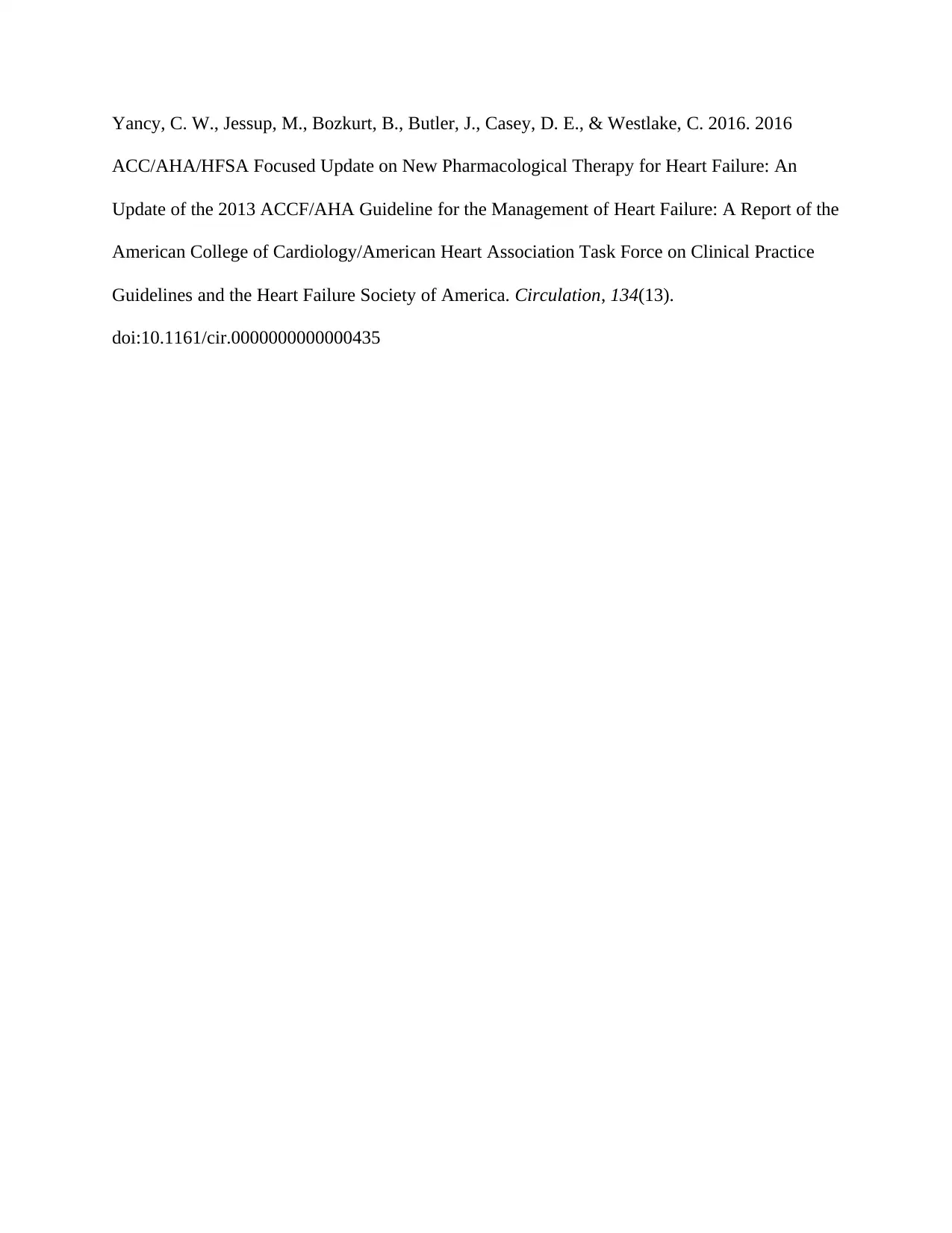
Yancy, C. W., Jessup, M., Bozkurt, B., Butler, J., Casey, D. E., & Westlake, C. 2016. 2016
ACC/AHA/HFSA Focused Update on New Pharmacological Therapy for Heart Failure: An
Update of the 2013 ACCF/AHA Guideline for the Management of Heart Failure: A Report of the
American College of Cardiology/American Heart Association Task Force on Clinical Practice
Guidelines and the Heart Failure Society of America. Circulation, 134(13).
doi:10.1161/cir.0000000000000435
ACC/AHA/HFSA Focused Update on New Pharmacological Therapy for Heart Failure: An
Update of the 2013 ACCF/AHA Guideline for the Management of Heart Failure: A Report of the
American College of Cardiology/American Heart Association Task Force on Clinical Practice
Guidelines and the Heart Failure Society of America. Circulation, 134(13).
doi:10.1161/cir.0000000000000435
1 out of 11
Related Documents
Your All-in-One AI-Powered Toolkit for Academic Success.
+13062052269
info@desklib.com
Available 24*7 on WhatsApp / Email
![[object Object]](/_next/static/media/star-bottom.7253800d.svg)
Unlock your academic potential
© 2024 | Zucol Services PVT LTD | All rights reserved.





